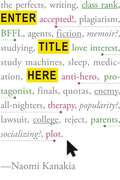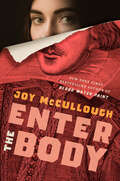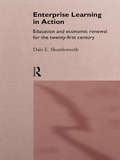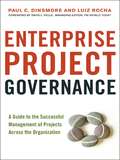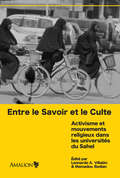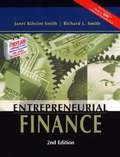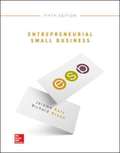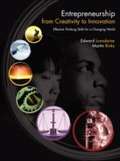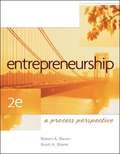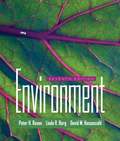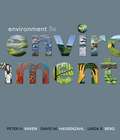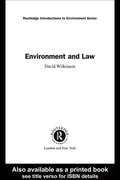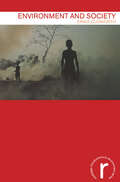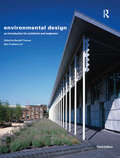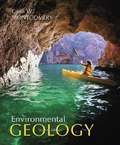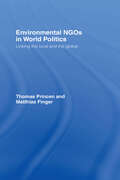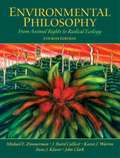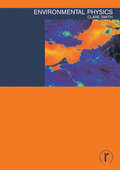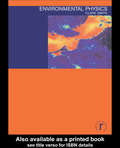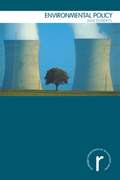- Table View
- List View
Enter Title Here
by Rahul KanakiaI'm your protagonist-Reshma Kapoor-and if you have the free time to read this book, then you're probably nothing like me. Reshma is a college counselor's dream. She's the top-ranked senior at her ultra-competitive Silicon Valley high school, with a spotless academic record and a long roster of extracurriculars. But there are plenty of perfect students in the country, and if Reshma wants to get into Stanford, and into med school after that, she needs the hook to beat them all. What's a habitual over-achiever to do? Land herself a literary agent, of course. Which is exactly what Reshma does after agent Linda Montrose spots an article she wrote for Huffington Post. Linda wants to represent Reshma, and, with her new agent's help scoring a book deal, Reshma knows she'll finally have the key to Stanford. But she's convinced no one would want to read a novel about a study machine like her. To make herself a more relatable protagonist, she must start doing all the regular American girl stuff she normally ignores. For starters, she has to make a friend, then get a boyfriend. And she's already planned the perfect ending: after struggling for three hundred pages with her own perfectionism, Reshma will learn that meaningful relationships can be more important than success-a character arc librarians and critics alike will enjoy. Of course, even with a mastermind like Reshma in charge, things can't always go as planned. And when the valedictorian spot begins to slip from her grasp, she'll have to decide just how far she'll go for that satisfying ending. (Note: It's pretty far.) In this wholly unique, wickedly funny debut novel, Rahul Kanakia consciously uses the rules of storytelling-and then breaks them to pieces.
Enter the Body
by Joy McCullough&“At once tender, poetic and ferocious, Enter The Body breathes new life into the Bard&’s most tragic heroines. More than a tribute to Shakespeare, this kaleidoscopic, ambitious novel-in-verse gives Juliet, Ophelia, Cordelia, and Lavinia the chance to tell their own stories full of passion, justice, sisterhood, and love. Simply spectacular.&”—Michael L. Printz Award winner Laura Ruby, author of Bone GapIn the room beneath a stage's trapdoor, Shakespeare&’s dead teenage girls compare their experiences and retell the stories of their lives, their loves, and their fates in their own words. Bestselling author Joy McCullough offers a brilliant testament to how young women can support each other and reclaim their stories in the aftermath of trauma.
Enterprise Learning in Action: Education and Economic Renewal for the Twenty-First Century
by Dale ShuttleworthFirst Published in 2004. Routledge is an imprint of Taylor & Francis, an informa company.
Enterprise Project Governance: A Guide to the Successful Management of Projects Across the Organization
by Paul C. Dinsmore Luiz RochaNew projects are the key to ensuring an organization's growthùand as we enter an increasingly competitive global economy, companies of all stripes struggle to effectively govern the multiplicity of projects needed to survive and prosper. Enterprise Project Governance reveals proven techniques for dealing with simultaneous initiatives and ensuring that programs and projects align with the priorities, resources, and strategies of the organizationùand ultimately create value. Complete with enlightening examples and case studies, the book provides readers with practical methods for incorporating enterprise project governance into their organization's culture, synchronizing it with corporate governance, and maximizing efficiency and results across departments. Whether one's view is from the boardroom, the executive suite, the project management office, or the project trenches, this is the essential guide for anyone managing multiple projects.
Entre le Savoir et le Culte: Activisme et mouvements religieux dans les universités du Sahel
by Leonardo A. Villalón« Entre le Savoir et le Culte présente des études et documents originaux qui mettent à jour l’évolution de l’islam et du christianisme parmi les étudiants d’universités des pays du Sahel. Il révèle les fissures et les conflits entre les groupes, et analyse leurs modes oraux, écrits et vestimentaires d’affichage et de performance. Cet ouvrage apporte ainsi un puissant éclairage sur l’emprise du religieux sur l’élite en formation, et examine les deux interrogations qui alimentent l’activisme religieux universitaire : la signification de la revendication d’une identité musulmane ou chrétienne, et comment celle-ci façonne la modernité des deux religions et vice-versa. A lire pour comprendre le dynamisme des terribles crises qui amènent la région sahélienne à se tourner sur elle-même. » – Mamadou Diouf, Leitner Family Professor of African Studies, Columbia University, États-Unis. « Quelquefois négligées ou mal comprises par les analystes étrangers, les universités sahéliennes sont le théâtre de débats profonds sur l’identité nationale, et d’importantes négociations autour de la religiosité et de l’ethnicité. Cette collection rassemble les travaux d’éminents spécialistes dans ce domaine, et propose une perspective riche et comparative de leur travail collectif, ancrée dans leur recherche sur le terrain. L’ouvrage sera indispensable à tous les chercheurs, analystes, et décideurs politiques qui travaillent sur le Sahel. Ces chapitres contribueront beaucoup à la compréhension des expériences et priorités d’une génération d’activistes et de leaders qui marqueront la région dans les années à venir. » – Alex Thurston, Assistant Professor of Political Science, Université de Cincinnati, États-Unis
Entrepreneurial Finance
by Richard L. Smith Janet Kiholm SmithSmith and Smith apply current thinking in the areas of valuation, real options, and the economics of contracts to new venture decision making. Readers learn to think of new ventures as portfolios of real options, value financial claims of the entrepreneur and venture capital investors, and structure financial contracts in light of new venture information problems. They also learn to use simulation and scenario analysis to evaluate the implications of uncertainty and financial decisions. * Stresses the importance of strategy in new venture planning. * Develops real-world context through relevant examples. * Spreadsheet modeling and simulation using custom software provides hands-on learning.
Entrepreneurial Small Business
by Jerome Katz Richard P. GreenEntrepreneurial Small Business (ESB) provides students with a clear vision of small business as it is today. ESB focuses on the distinctive nature of small businesses that students might actually start versus high growth firms. The authors of ESB incorporate the latest findings and best practices from academic and consulting arenas, and recognize the distinction between entrepreneurs who aim to start the successor to Amazon.com or the pizza place around the corner. Entrepreneurial Small Business focuses on the small businesses students might actually start.
Entrepreneurship from Creativity to Innovation: Effective Thinking Skills for a Changing World
by Martin Binks Edward LumsdaineEntrepreneurship: From Creativity to Innovation is a unique guide for students, potential entrepreneurs and inventors, business managers, team leaders, or anyone seeking to become a more effective problem solver and innovator. It focuses on the creative thinking and problem solving skills needed to succeed in our rapidly changing, high-tech world. This "entrepreneurial" thinking will empower you to cope with uncertainty and behave with greater flexibility in your professional and personal life--these skills are for everyone! Learning is reinforced through application to communication, teamwork and above all to entrepreneurship. You will gain a basic understanding of innovation--a valuable skill in demand by employers who recognize the ability to innovate as a key for remaining competitive in the global marketplace. At a time when traditional jobs are disappearing, you will be able to recognize and profit from new opportunities.
Entrepreneurship: A Process Perspective (2nd Edition)
by Robert A. Baron Scott Andrew ShaneCurrent, comprehensive, and cutting edge, ENTREPRENEURSHIP: A PROCESS PERSPECTIVE equips potential entrepreneurs with the tools and insight for success. With solid theory and relevant examples, this thorough resource covers the entire process of building a business. Seasoned instructors and entrepreneurial authorities, Professors Baron and Shane deliver a practical, applied process approach with a multidisciplinary perspective, drawing on knowledge from the studies of economics, psychology, and other areas. The book begins with recognizing opportunity and building a team, and then moves through assembling finances, the business plan, legal issues, marketing, growth, and exit strategies. Rather than getting bogged down in excessive discussions of theory, Baron and Shane use real-world examples to illustrate how students can apply chapter concepts to their own business ventures. Thoroughly updated and revised based on student and professor feedback, the second edition adds a chapter on legal issues specific to entrepreneurs--including intellectual property considerations--and an appendix on key accounting principles entrepreneurs should know. A new chapter on growth strategies for new ventures is coupled with a chapter on managing new ventures for growth. In addition, new boxed features shed light on common myths and misperceptions about entrepreneurship. The book is also packed with hands-on applications--including a case written specifically for each chapter--giving students experience putting text concepts into real-world action.
Entrepreneurship: Successfully Launching New Ventures
by R. Duane Ireland Bruce R. Barringer'Entrepreneurship' introduces readers to the process of entrepreneurial success and shows them how to be effective every step of the way.
Environment (7th Edition)
by Linda R. Berg Peter H. Raven David M. HassenzahlOffering a more concise resource for environmental scientists, this seventh edition explores important environmental issues and shows how to apply this information on the job. It focuses on a systems approach, presenting a framework for thinking about environmental science.
Environment (Eighth Edition)
by Linda R. Berg Peter H. Raven David M. HassenzahlThe 8th Edition of "Environment" builds on the previous comprehensive, systems-based environmental science issue with more in-depth information on systems approach, which emphasizes the interconnected nature of environmental science throughout the text. The book is even more reader-friendly integrated learning system designed to help move from general concepts to specific applications and continues to focus on currency. It presents the basic facts, various perspectives on issues, and framework to help readers reach their own informed decisions in a changing marketplace.
Environment and Law (Routledge Introductions to Environment: Environment and Society Texts)
by David WilkinsonThis textbook provides a concise introduction for students with little or no legal background, to the role of law in environmental protection. It describes and explains law and legal systems, the concept of the environment, sources of environmental law and some of the techniques used in environmental law. Interdisciplinary in approach, the book explores some of the major connections between law and the disciplines of ethics, science, economics and politics.Environment and Law offers a greater understanding of international and national environmental law and has case-studies from all over the world, including examples from UK, US and Australian law.
Environment and Society (Routledge Introductions to Environment: Environment and Society Texts)
by Erika CudworthAt the start of the twenty-first century, it can be argued that human societies have a greater impact on the environment than ever before. We have always been dependent upon, and interacted with, the 'natural' environment. However, the dramatic social changes of the past three centuries, have altered the form of our relationship with non-human nature to the extent that some would see people/planet relations as in a situation of crisis.Environment and Society provides a comprehensive and critical account of the ways in which we can think about the relationship between human societies and the environments with which they interact. It argues that human societies are ecologically embedded, and that environments are often socially embedded and constituted. It makes the different theoretical positions and empirical studies accessible to students, and includes chapter outlines and summaries, annotated further reading, boxed case-studies and discussion points.
Environment: The Science Behind the Stories (Second Edition)
by Scott Brennan Jay Withgott"Environment: The Science Behind the Stories" is an introductory textbook that uses case studies and real data to demonstrate the role of science in identifying and solving pressing environmental problems. The book integrates case studies into the body of the text to provide a contextual framework for the science readers are learning. With only 22 chapters, this book avoids the encyclopedic approach of other textbooks on the market. A panoramic view of environmental science and issues, including the important policy, economic, and ethical issues behind the scientific ones. For college instructors, students, and anyone interested in environmental science and issues.
Environmental Biology and Ecology Laboratory Manual (Fifth Edition)
by Les M. LynnThis manual has engaging lab exercises for students learning environmental biology and ecology and also intends to spark a curiosity into the environment around them.
Environmental Chemistry
by John WrightMany controversial issues revolve around complex scientific arguments which can be better understood with at least a minimal knowledge and understanding of the chemical reactions and processes going on in the world around us.This textbook offers an accessible introduction to chemical principles and concepts, and applies them to relevant environmental situations and issues. Written for students who have not taken A' level chemistry, this book bridges the gap between GSCE chemistry and first year undergraduate level.
Environmental Design: An Introduction for Architects and Engineers
by Randall ThomasWritten and edited by a team of specialists at Max Fordham LLP, one of the UK’s leading environmental and building services engineering consultancies, Environmental Design is the result of their extensive experience in designing environmentally-friendly buildings. The principles of their approach, which they have taught in numerous schools of architecture and engineering, are clearly presented here. The book starts with some basic scientific principles and environmental issues and then moves on to site planning, energy use, materials and building form. Natural ventilation systems, high-efficiency mechanical equipment and alternative energy sources are also covered. State-of-the-art buildings of exceptional quality are incorporated throughout the text and illustrate the authors’ belief that environmentally responsible architecture can be visually exciting. They conclude with a selection of detailed case studies of award-winning projects – including, new for this third edition, Beaufort Court, King's Langley and the National Trust Headquarters, Swindon. This book is essential reading for architects, engineers, planners and students of these disciplines.
Environmental Economics
by Iain L. Fraser Alfred EndresThis intermediate-level undergraduate textbook in environmental economics builds on the microeconomics courses students take in their first year. It intentionally does not survey the whole field or present every possible topic. Instead, there is a clear focus on the theory of environmental policy and its practical applications. Most of the applied parts of the book deal with the economics of environmental policy in the European Union and in the United States. The book combines basic environmental economic analysis, such as the internalization of externalities, with recent developments in this field, including induced technical change and coalition theory. Moreover, topics from daily policy debates such as global warming are put into economic perspective. This is done in an intelligible form for advanced undergraduate students of economics, business administration, and related fields. Each part of the book contains a set of exercises and suggested solutions.
Environmental Geology (Seventh Edition)
by Carla W. MontgomeryPresents the student with an overview of environmental geology. This book looks both at how the earth developed into its present condition. It helps provide the students with a useful foundation for discussing and evaluating specific environmental issues, as well as for developing ideas about how the problems should be solved.
Environmental NGOs in World Politics: Linking the Local and the Global
by Thomas Princen Matthias FingerAt a time when states are reactive, at best, to the global ecological crisis and when economic globalization seems to be significantly contributing to the acceleration of that crisis, environmental non-governmental orgainisations (NGOs) are proliferating. This book explains the key role of NGOs in an emerging world environmental politics, showing how NGOs act both as independent bargainers and as agents of social learning, to link biophysical conditions to the political realm at both the local and global levels.Throught the use of case studies the authors reveal the richness and diversity of NGO activity and the dificulty of the choices facing decision-makers in their attempts to protect the environment, seek new forms of governance and foster social environmental learning. The book generates questions that are central, not only to an understanding of NGO relations, but to the study of international environmental politics.Environmental NOGs in World Politics will be of great interest to upper level student sand scholars of both environmental politics and international relations. It will also appeal to environmental-policy professionals.
Environmental Philosophy: From Animal Rights to Radical Ecology
by J. Baird Callicott John Clark Michael E. Zimmerman Irene J. Klaver Karen J. WarrenEdited by leading experts in contemporary environmental philosophy, this anthology features the best available selections that cover the full range of positions within this rapidly developing field. Divided into four sections that delve into the vast issues of contemporary Eco-philosophy, the Fourth Edition now includes a section on Continental Environmental Philosophy that explores current topics such as the social construction of nature, and eco-phenomenology. Each section is introduced and edited by a leading philosopher in the field. For professionals with a career within the environmental field including law, politics, conservation, geography, and biology.
Environmental Physics (Routledge Introductions To Environment: Environmental Science Ser.)
by Clare SmithFirst Published in 2002. Environmental Physics is a comprehensive introduction to the physical concepts underlying environmental science. The importance and relevance of physics is emphasised by its application to real environmental problems with a wide range of case studies. Applications included cover energy use and production, global climate, the physics of living things, radioactivity, environmental remote sensing, noise pollution and the physics of the Earth. The book makes the subject accessible to those with little physics background, keeping mathematical treatment straightforward. The text is lively and informative, and is supplemented by numerous illustrations, photos, tables of useful data, and a glossary of key terms.
Environmental Physics (Routledge Introductions to Environment: Environmental Science)
by Clare SmithEnvironmental Physics is a comprehensive introduction to the physical concepts underlying environmental science. The importance and relevance of physics is emphasised by its application to real environmental problems with a wide range of case studies. Applications included cover energy use and production, global climate, the physics of living things, radioactivity, environmental remote sensing, noise pollution and the physics of the Earth. The book makes the subject accessible to those with little physics background, keeping mathematical treatment straightforward. The text is lively and informative, and is supplemented by numerous illustrations, photos, tables of useful data, and a glossary of key terms.
Environmental Policy (Routledge Introductions to Environment: Environment and Society Texts)
by Jane RobertsWithin the overall context of sustainable development Environmental Policy discusses the opportunities and constraints that environmental systems place upon the operation of human systems. It suggests environmental policy is a potential way to modify the operation of human systems so that they function within environmental constraints. Key social scientific concepts (political, social and economic) are used to explain the background for the formulation and implementation of environmental policy.Environmental problems, the role of humans in creating them, sustainable development and how this concept relates to environmental policy are all introduced. The book then considers environmental policy formulation, implementation and evaluation, within three specific contexts: the firm, the nation state and at the international level. It also reviews the place of economics, science and technology in environmental policy.Detailed case-studies, drawn from a range of international examples, are used throughout to illustrate issues such as global warming, international trade, tourism and the human rights of indigenous peoples. It is well illustrated and includes end of chapter summaries and further reading.
